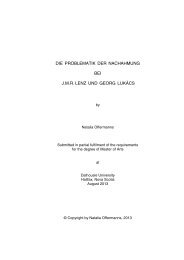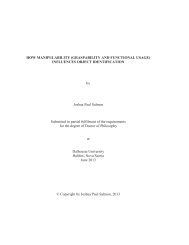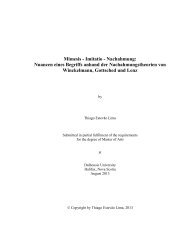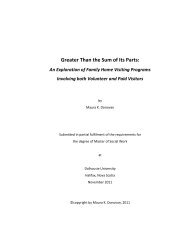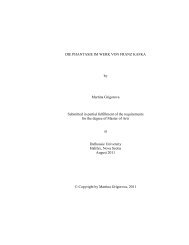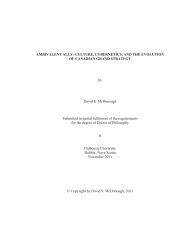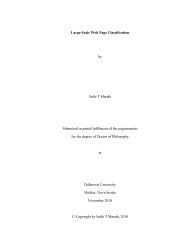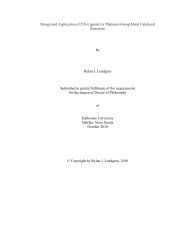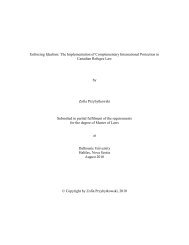ADAPTING TRISTRAM SHANDY by Adria Young Submitted in ...
ADAPTING TRISTRAM SHANDY by Adria Young Submitted in ...
ADAPTING TRISTRAM SHANDY by Adria Young Submitted in ...
Create successful ePaper yourself
Turn your PDF publications into a flip-book with our unique Google optimized e-Paper software.
work, aided <strong>by</strong> the relationship between visual cues and textual <strong>in</strong>formation.<br />
Visual cues <strong>in</strong> comic books usually range from the iconic to the textual. McCloud<br />
sees the text and image relationship as an “imitation” of earlier forms of textual<br />
communication (151), and comics <strong>in</strong>corporate a range of symbolic language extracted<br />
from various other forms of the visual and textual arts. 55 That is, comic books operate <strong>in</strong> a<br />
multimodal and <strong>in</strong>termedial way <strong>by</strong> virtue of the convergence between text and image, all<br />
mediated on the page. “Comics,” McCloud writes, act as an “<strong>in</strong>termediary between<br />
storyteller and audience” <strong>in</strong> a way that promotes an “awareness of [the] form” (172) of<br />
the medium. Like Tristram Shandy’s deliberate attention to the material elements of the<br />
text, and Sterne’s <strong>in</strong>clusion of graphic signifiers, Rowson’s version creates the same<br />
sense of awareness about its form, and role of visual images <strong>in</strong> narration. In most comic<br />
books, McCloud notes, the “words and images are kept separate” (144). Often, the text<br />
that relates to the action is dist<strong>in</strong>ct from the image, much like a Hogarthian panel where<br />
the text supplements the image. McCloud calls this an “<strong>in</strong>terdependent” text to image<br />
relationship (155), which is the most commonly used method <strong>in</strong> comic book design.<br />
There are a number of other ways that text and image <strong>in</strong>teract, however, like “duo-<br />
specific,” when the same message is conveyed from the text and the image, or “additive,”<br />
when the text “amplifies or elaborates” upon the image, or “montage,” when “parts of<br />
words or images” are used (154-55). Rowson’s comic book, however, employs all three<br />
of these styles, sometimes simultaneously. Multiple dialogues with<strong>in</strong> panels, which are<br />
meant to relate to multiple actions, confuse the priority and order of the text and visual<br />
image. In many panels, there are several conversations go<strong>in</strong>g on while the text is visually<br />
recreated. The narrative is not divided as <strong>in</strong> conventional graphic novels and comics; it is<br />
41



